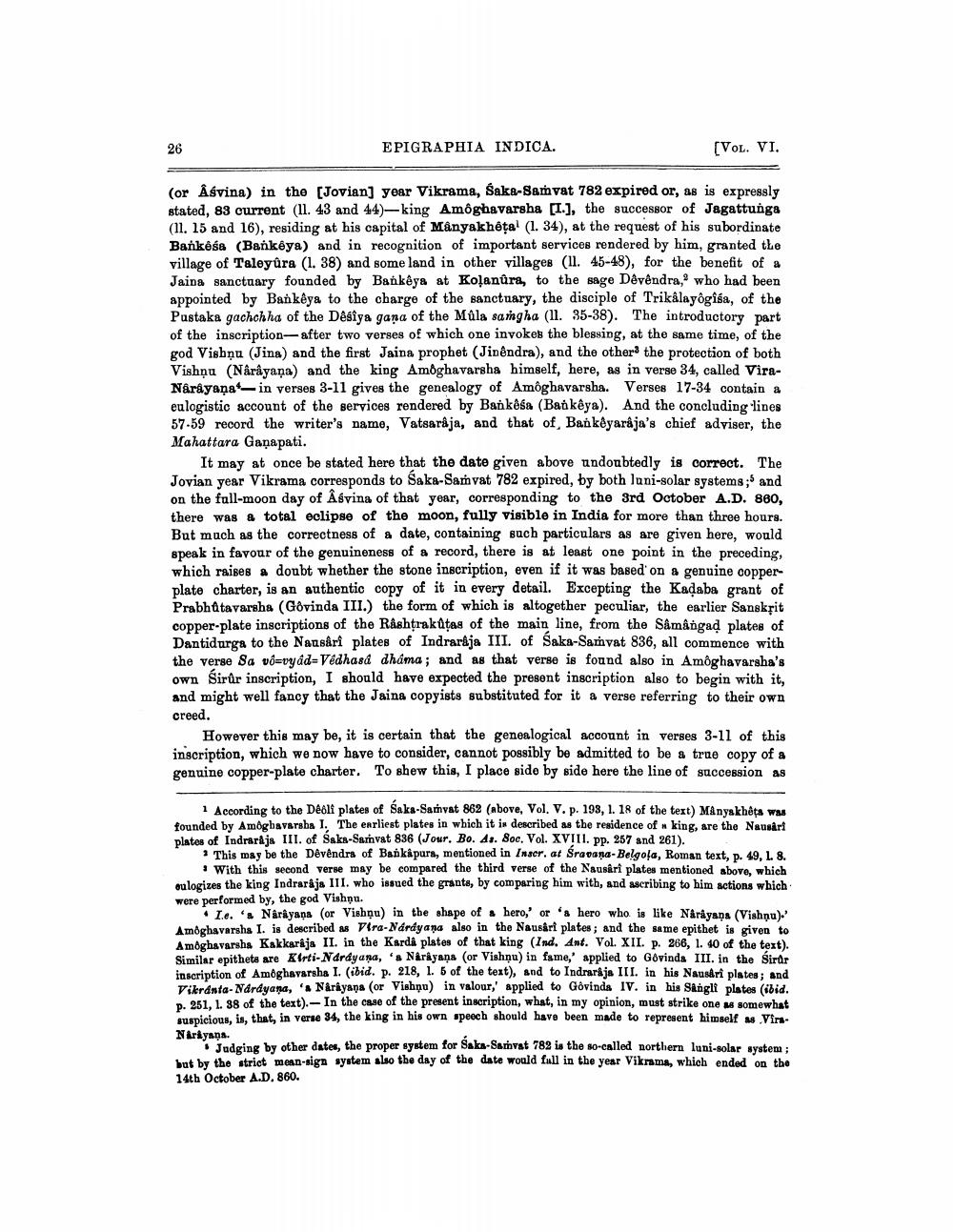________________
26
EPIGRAPHIA INDICA.
(VOL. VI.
(or Åsvina) in the [Jovian] year Vikrama, Saka-Samvat 782 expired or, as is expressly stated, 83 current (11. 43 and 44)-king Amôghavarsha [1.], the successor of Jagattunga (11. 15 and 16), residing at his capital of Mânyakhetal (1. 34), at the request of his subordinate Bankesa (Bankêya) and in recognition of important services rendered by him, granted the village of Taleyûra (1. 38) and some land in other villages (11.45-48), for the benefit of a Jaina sanctuary founded by Bankêya at Koļanûra, to the sage Devendra, who had been appointed by Bankêya to the charge of the sanctuary, the disciple of Trikålayôgisa, of the Pustaka gachchha of the Desiya gana of the Mûla sangha (11. 35-38). The introductory part of the inscription- after two verses of which one invokes the blessing, at the same time, of the god Vishnu (Jina) and the first Jaina prophet (Jinêndra), and the other the protection of both Vishnu (Narayaņa) and the king Amoghavarsha himself, here, as in verse 34, called ViraNarayana - in verses 3-11 gives the genealogy of Amoghavarsha. Verses 17-34 contain a eulogistic account of the services rendered by Bankeśa (Bankêya). And the concluding lines 57.59 record the writer's name, Vatsaråja, and that of Bankêyaraja's chief adviser, the Mahattara Ganapati.
It may at once be stated here that the date given above undoubtedly is correct. The Jovian year Vikrama corresponds to Saka-Samvat 782 expired, by both luni-solar systems; and on the fall-moon day of Åsvina of that year, corresponding to the 3rd October A.D. 860, there was a total eclipse of the moon, fully visible in India for more than three hours. But much as the correctness of a date, containing such particulars as are given here, would speak in favour of the genuineness of a record, there is at least one point in the preceding, which raibes a doubt whether the stone inscription, even if it was based on a genuine copper plate charter, is an authentic copy of it in every detail. Excepting the Kadaba grant of Prabhůtavarsha (Govinda III.) the form of which is altogether peculiar, the earlier Sanskřit copper-plate inscriptions of the Rashtrakūtas of the main line, from the Såmångad plates of Dantidurga to the Nausäri plates of Indraraja III. of Saka-Samvat 836, all commence with the verge Sa võzvyád-Védhasa dhama; and as that verse is found also in Amôghavarsha's own Sirûr inscription, I should have expected the present inscription also to begin with it, and might well fancy that the Jaina copyists substituted for it a verse referring to their own creed.
However this may be, it is certain that the genealogical account in verses 3-11 of this inscription, which we now have to consider, cannot possibly be admitted to be a true copy of a genuine copper-plate charter. To shew this, I place side by side here the line of succession as
1 According to the Debli plates of Saka-Samvat 862 (above, Vol. V. p. 198, 1. 18 of the text) Minyakhota was founded by Amoghavarsha I, The earliest plates in which it is described as the residence of king, are the Naukri plates of Indraraja III. of Saka-Samvat 836 (Jour. Bo. As. Soc. Vol. XVIII. pp. 257 and 261).
This may be the Devendrs of Bankápurs, mentioned in Inscr. at Sravana-Belgola, Roman text, p. 49, L. 8.
With this second verse may be compared the third verse of the Nausfri plates mentioned above, which wlogizes the king Indraraja III. who issued the grants, by comparing him with, and ascribing to him actions which were performed by, the god Vishnu.
Ie. ' Narayana (or Vishņu) in the shape of a hero,' or 's hero who is like Nárayana (Vishnu). machavarshs I. is described as Vira-Nardy and also in the Nausari plates; and the same epithet is given to Amoghavarsha Kakkaraja II. in the Kardå plates of that king (Ind. Ant. Vol. XII. p. 268, 1. 40 of the text). Similar epithets are Kirti-Nardy ana, 'a Narayans (or Vishnu
Kori-Nardyana, 'Narayana (or Vishņu) in fame,' applied to Govinda III. in the Sirar n tion of AmAghayarsha I. (ibid. p. 218, l. 5 of the text), and to Indrar ja 111. in his Nausdri plates: spd Vikranta-Nardyana, 'Narayana (or Vishņu) in valour,' applied to Govinda IV. in his Sangli plates (ibid.
. 251. 1. 38 of the text).- In the case of the present inscription, what, in my opinion, must strike one is somewhat imenicions in that, in verse 34, the king in his own speech should have been made to represent himself as Virs. Nariyana.
i Judging by other dates, the proper system for Saka-Samvat 782 is the so-called northern luni-solar system : bat by the strict mean-sign system also the day of the date would full in the year Vikrama, which ended on the 14th October A.D. 860.




